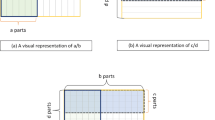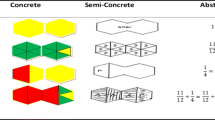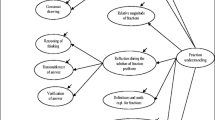Abstract
This article explores three attributes of teachers’ understanding of fraction magnitude: the accuracy and reasonableness of teachers’ estimations in response to fraction arithmetic tasks as well as the alignment of the estimation strategies they used with the concept of fraction magnitude. The data were collected from a national sample of mathematics teachers in grades 3–7 in which fraction concepts were taught (N = 603). The results indicated the teachers’ estimations were only partially accurate and reasonable, particularly when fraction division was involved. Furthermore, teachers’ credentials and the grade level at which they taught mathematics were significantly related to teachers’ understanding of fraction magnitude.



Similar content being viewed by others
Notes
Participants were first completed a screening survey to ensure the data were collected from the targeted sample. The screening survey began with general questions regarding the participant’s career and was followed by specific questions, such as at what grade level the teacher taught mathematics. Those who were eligible to participate in the study were allowed to continue to take the survey, and they completed an additional set of questions regarding their educational background. Teachers who participated in the study were compensated with an online gift card.
Teachers saw these questions in a randomized order to reduce the error in their responses.
Teachers’ accuracy score was reverse-coded because a higher score indicated lower accuracy.
Indeed, the accuracy of teachers’ estimations for the division of fractions was statistically lower than the accuracy of their estimations for the addition problem, t(559) = −9.01, p < .001.
A significantly higher percentage of teachers provided a reasonable estimation for the addition of fractions (75.6%) compared with the division of fractions (54.1%), McNemar’s chi2= 71.05, p < .0001.
References
Bartell, T. G., Webel, C., Bowen, B., & Dyson, N. (2013). Prospective teacher learning: recognizing evidence of conceptual understanding. Journal of Mathematics Teacher Education, 16(1), 57–79.
Beckmann, S. (2018). Mathematics for elementary teachers with activities (5th ed.). New York, NY: Pearson.
Behr, M., Lesh, R., Post, T., & Silver, E. (1983). Rational number concepts. In R. Lesh & M. Landau (Eds.), Acquisition of mathematics concepts and processes (pp. 91–125). New York: Academic Press.
Behr, M. J., Post, T. R., & Wachsmuth, I. (1986). Estimation and children’s concept of rational number size. In H. L. Schoen (Ed.), Estimation and mental computation (pp. 103–111). Reston, VA: NCTM.
Behr, M. J., Wachsmuth, I., & Post, T. R. (1985). Construct a sum: A measure of children’s understanding of fraction size. Journal for Research in Mathematics Education, 16(2), 120–131.
Borko, H., Eisenhart, M., Brown, C. A., Underhill, R. G., Jones, D., & Agard, P. C. (1992). Learning to teach hard mathematics: Do novice teachers and their instructors give up too easily?. Journal for Research in Mathematics Education, 23(3), 194–222.
Copur-Gencturk, Y. (2021). Teachers’ conceptual understanding of fraction operations: Results from a National Sample of Elementary School Teachers Educational Studies in Mathematics. https://doi.org/10.1007/s10649-021-10033-4.
Deliyianni, E., Gagatsis, A., Elia, I., & Panaoura, A. (2016). Representational flexibility and problem-solving ability in fraction and decimal number addition: A structural model. International Journal of Science and Mathematics Education, 14(2), 397–417.
DeWolf, M., & Vosniadou, S. (2015). The representation of fraction magnitudes and the whole number bias reconsidered. Learning and Instruction, 37, 39–49.
Fisher, L. C. (1988). Strategies used by secondary mathematics teachers to solve proportion problems. Journal for Research in Mathematics Education, 19(2), 157–168.
Hill, H. C. (2007). Mathematical knowledge of middle school teachers: Implications for the No Child Left Behind policy initiative. Educational Evaluation and Policy Analysis, 29(2), 95–114. https://doi.org/10.3102/0162373707301711.
Hill, H. C. (2010). The nature and predictors of elementary teachers’ mathematical knowledge for teaching. Journal for Research in Mathematics Education, 41(5), 513–545.
Izsák, A., Jacobson, E., & Bradshaw, L. (2019). Surveying middle-grades teachers’ reasoning about fraction arithmetic in terms of measured quantities. Journal for Research in Mathematics Education, 50(2), 156–209.
Lamon, S. J. (2007). Rational numbers and proportional reasoning: Toward a theoretical framework for research. In F. K. Lester (Ed.), Second handbook of research on mathematics teaching and learning (pp. 629–667). Information Age Publishing.
Lehrer, R., & Franke, M. L. (1992). Applying personal construct psychology to the study of teachers' knowledge of fractions. Journal for Research in Mathematics Education, 23(3), 223–241.
Lee, M. Y., & Lee, J.-E. (2020). Spotlight on area models: Pre-service teachers’ ability to link fractions and geometric measurement. International Journal of Science and Mathematics Education. https://doi.org/10.1007/s10763-020-10098-2.
Lemonidis, C., Tsakiridou, H., & Meliopoulou, I. (2018). In-service teachers’ content and pedagogical content knowledge in mental calculations with rational numbers. International Journal of Science and Mathematics Education, 16(6), 1127–1145.
Ma, L. (1999). Knowing and teaching elementary mathematics: Teachers’ understanding of fundamental mathematics in China and the United States. Routledge.
Mazzocco, M. M., & Devlin, K. T. (2008). Parts and ‘holes’: Gaps in rational number sense among children with vs. without mathematical learning disabilities. Developmental Science, 11(5), 681–691.
National Mathematics Advisory Panel. (2008). Foundations for success: The final report of the National Mathematics Advisory Panel. US Department of Education.
Newton, K. J. (2008). An extensive analysis of preservice elementary teachers’ knowledge of fractions. American Educational Research Journal, 45(4), 1080–1110.
Olanoff, D., Lo, J.-J., & Tobias, J. (2014). Mathematical content knowledge for teaching elementary mathematics: A focus on fractions. The Mathematics Enthusiast, 11(2), 267–310.
Post, T. R., Cramer, K. A., Behr, M., Lesh, R., & Harel, G. (1993). Curriculum indications from research on the learning, teaching and assessing of rational number concepts: Multiple research perspective. In T. Carpenter & E. Fennema (Eds.), Learning, teaching and assessing rational number concepts: Multiple research perspective. Madison: University of Wisconson.
Rinne, L. F., Ye, A., & Jordan, N. C. (2017). Development of fraction comparison strategies: A latent transition analysis. Developmental Psychology, 53(4), 713–730. https://doi.org/10.1037/dev0000275.
Siegler, R. S. (2016). Magnitude knowledge: The common core of numerical development. Developmental Science, 19(3), 341–361.
Siegler, R. S., & Lortie-Forgues, H. (2015). Conceptual knowledge of fraction arithmetic. Journal of Educational Psychology, 107(3), 909–918.
Siegler, R. S., Duncan, G. J., Davis-Kean, P. E., Duckworth, K., Claessens, A., Engel, M., Susperreguy, M. I., & Chen, M. (2012). Early predictors of high school mathematics achievement. Psychological Science, 23(7), 691–697.
Siegler, R. S., Thompson, C. A., & Schneider, M. (2011). An integrated theory of whole number and fractions development. Cognitive Psychology, 62(4), 273–296.
Snyder, T. D., de Brey, C., & Dillow, S. A. (2019). Digest of education statistics 2017, NCES 2018-070. National Center for Education Statistics.
Thanheiser, E., Olanoff, D., Hillen, A., Feldman, Z., Tobias, J. M., & Welder, R. M. (2016). Reflective analysis as a tool for task redesign: The case of prospective elementary teachers solving and posing fraction comparison problems. Journal of Mathematics Teacher Education, 19(2–3), 123–148.
Toluk-Uçar, Z. (2009). Developing pre-service teachers understanding of fractions through problem posing. Teaching and Teacher Education, 25(1), 166–175.
Torbeyns, J., Schneider, M., Xin, Z., & Siegler, R. S. (2015). Bridging the gap: Fraction understanding is central to mathematics achievement in students from three different continents. Learning and Instruction, 37, 5–13.
Tsao, Y. L. (2005). The number sense of preservice elementary school teachers. College Student Journal, 39(4), 647–680.
Van Hoof, J., Verschaffel, L., & Van Dooren, W. (2015). Inappropriately applying natural number properties in rational number tasks: Characterizing the development of the natural number bias through primary and secondary education. Educational Studies in Mathematics, 90(1), 39–56.
Whitacre, I., & Nickerson, S. D. (2016). Investigating the improvement of prospective elementary teachers’ number sense in reasoning about fraction magnitude. Journal of Mathematics Teacher Education, 19(1), 57–77.
Yang, D. C. (2007). Investigating the strategies used by pre-service teachers in Taiwan when responding to number sense questions. School Science and Mathematics, 107(7), 293–301.
Yang, D. C., Reys, R. E., & Reys, B. J. (2009). Number sense strategies used by pre-service teachers in Taiwan. International Journal of Science and Mathematics Education, 7(2), 383–403.
Zhou, Z., Peverly, S. T., & Xin, T. (2006). Knowing and teaching fractions: A cross-cultural study of American and Chinese mathematics teachers. Contemporary Educational Psychology, 31(4), 438–457.
Funding
This work was supported by the National Science Foundation (DRL-1751309) and the Herman & Rasiej Mathematics Initiative. Any opinions, findings, and conclusions or recommendations expressed in this material are those of the author and do not necessarily reflect the views of the National Science Foundation or Herman & Rasiej Mathematics Initiative.
Author information
Authors and Affiliations
Corresponding author
Supplementary Information
ESM 1
(DOCX 17.9 kb)
Rights and permissions
About this article
Cite this article
Copur-Gencturk, Y. Teachers’ Knowledge of Fraction Magnitude. Int J of Sci and Math Educ 20, 1021–1036 (2022). https://doi.org/10.1007/s10763-021-10173-2
Received:
Accepted:
Published:
Issue Date:
DOI: https://doi.org/10.1007/s10763-021-10173-2




